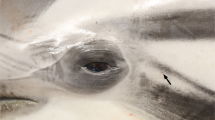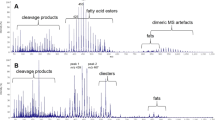Summary
Siliconized, glass micropipets whose tips were filled with oil were used to obtain small (<100 nl) liquid samples from perilymphatic and endolymphatic regions of the inner ears of anesthetized animals: 3 cats, 19 alligator lizards (Gerrhonotus multicarinatus), and 8 skates (Raja erinacea). Samples of cerebrospinal fluid and seawater were also obtained for skates. Electron probe microanalysis was used to measure the concentrations of the following elements in each sample: K, Na, Cl, Ca, Mg, P, S. The Na and K concentrations in cat perilymph (Fig. 1 and Table 2) agree with previous estimates (Table 4) while endolymph samples show relatively low Na and high K concentrations. From a comparison of our results with previous work (Table 3), we infer that contamination of endolymph samples with perilymph is relatively low in our study, and that no large species difference in endolymph content is indicated by present data available for mammals. Our results show that Cl concentration is higher and Ca and Mg concentrations are lower in endolymph than in perilymph. The composition of perilymph in cats and alligator lizards is roughly the same (Figs. 1 and 2, Table 2). Uncontaminated endolymph samples in lizards were apparently difficult to obtain, although the compositions of a few samples suggest that endolymph K concentration is high and Na concentration is low. In skates the concentration of Na is nearly the same in the two inner ear lymphs (Fig. 3 and Table 2), in contrast to the roughly hundredfold ratio of perilymph to endolymph Na concentrations found in the higher vertebrates. The element composition of perilymph is correlated with the composition of seawater in which the skates were kept, whereas the endolymph composition shows no such correlation.
Similar content being viewed by others
Abbreviations
- CSF:
-
cerebrospinal fluid
- EL samples, PL samples:
-
samples judged by visual criteria alone to be from the endolymphatic and perilymphatic spaces, respectively
- SW:
-
sea water
References
Aldred, P., Hallpike, C.S., Ledoux, A.: Observations on the osmotic pressure of the endolymph. J. Physiol. (Lond.)98, 446–453 (1940)
Bagger-Sjöbäck, D., Flock, Å.: Freeze-fracturing of the auditory basilar papilla in the lizardCalotes versicolor. Cell Tiss. Res.177, 431–443 (1977)
Baird, I.L.: Anatomical features of the inner ear in submammalian vertebrates. In: Handbook of sensory physiology, Vol. V/1: Auditory system (eds. W.D. Keidel, W.D. Neff), pp. 159–212. Berlin-Heidelberg-New York: Springer 1974
Baker, P.F., Reuter, H.: Calcium movement in excitable cells. Oxford: Pergamon Press 1975
Bosher, S.K., Warren, R.L.: Observations on the electrochemistry of the cochlear endolymph of the rat: a quantitative study of its electrical potential and ionic composition as determined by means of flame spectrophotometry. Proc. roy. Soc. B171, 227–247 (1968)
Bosher, S.K., Warren, R.L.: A study of the electrochemistry and osmotic relationships of the cochlear fluids in the neonatal rat at the time of the development of the endocochlear potential. J. Physiol. (Lond.)212, 739–761 (1971)
Brusilow, S.W., Gordes, E.: The mutual independence of the endolymphatic potential and the concentrations of sodium and potassium in endolymph. J. clin. Invest.52, 2517–2521 (1973)
Citron, L., Exley, D.: Recent work on the biochemistry of the labyrinthine fluids. Proc. roy. Soc. Med.50, 697–701 (1957)
Citron, L., Exley, D., Hallpike, C.S.: Formation, circulation and chemical properties of the labyrinthine fluids. Brit. med. Bull.12, 101–104 (1956)
Cohn, E.S., Gordes, E.H., Brusilow, S.W.: Ethacrynic acid effect on the composition of cochlear fluids. Science171, 910–911 (1971)
Davies, D.G.: Biochemistry of the inner ear fluids — experimental and clinical observations. J. Laryngol.82, 301–311 (1968)
Desmedt, J.E., Robertson, D.: Ionic mechanism of the efferent olivocochlear inhibition studied by cochlear perfusion in the cat. J. Physiol. (Lond.)247, 407–428 (1975)
Duvall, A.J., Sutherland, C.R.: Cochlear transport of horseradish peroxidase. Ann. Otol. (St. Louis)81, 705–713 (1972)
Enger, P.S.: Ionic composition of the cranial and labyrinthine fluids and saccular D.C. potentials in fish. Comp. Biochem. Physiol.11, 131–137 (1964)
Erulkar, S.D., Maren, T.H.: Carbonic anhydrase and the inner ear. Nature (Lond.)189, 459–460 (1961)
Fänge, R., Larsson, Å., Lidman, U.: Fluids and jellies of the acustico-lateralis system in relation to body fluids inCoryphaenoides rupestris and other fishes. Mar. Biol.17, 180–185 (1972)
Flock, Å.: Electron probe determination of relative ion distribution in the inner ear. Acta otolaryngol. (Stockh.)83, 239–244 (1977)
Flock, Å., Jørgensen, M., Russell, I.: The physiology of individual hair cells and their synapses. In: Basic mechanisms in hearing (ed. A.R. Møller), pp. 273–306. New York: Academic Press 1973
Flock, Å., Russell, I.J.: The post-synaptic action of efferent fibres in the lateral line organ of the burbotLota lota. J. Physiol. (Lond.)235, 591–605 (1973)
Flock, Å., Russell, I.: Inhibition by efferent nerve fibres: action on hair cells and afferent synaptic transmission in the lateral line canal organ of the burbotLota lota. J. Physiol. (Lond.)257, 45–62 (1976)
Furukawa, T., Ishii, Y.: Neurophysiological studies on hearing in goldfish. J. Neurophysiol.30, 1377–1403 (1967)
Furukawa, T., Ishii, Y., Matsuura, S.: Synaptic delay and time course of postsynaptic potentials at the junction between hair cells and eighth nerve fibers in the goldfish. Jap. J. Physiol.22, 617–635 (1972)
Gulley, R.L., Reese, T.S.: Intercellular junctions in the reticular lamina of the organ of Corti. J. Neurocytol.5, 479–507 (1976)
Gutgesell, V.J.: Seasonal variation in the anoxia sensitivity of the lizard saccule. Comp. Biochem. Physiol.54, 407–408 (1976)
Harris, G.G., Frishkopf, L.S., Flock, Å.: Receptor potentials from hair cells of the lateral line. Science167, 76–79 (1970)
Hudspeth, A.J., Corey, D.P.: Sensitivity, polarity, and conductance change in the response of vertebrate hair cells to controlled mechanical stimuli. Proc. nat. Acad. Sci. (Wash.)74, 2407–2411 (1977)
Ilberg, Ch. von, Vosteen, K.-H.: Permeability of the inner ear membranes. Acta oto-laryng. (Stockh.)67, 165–167 (1969)
Il'inskii, O.B., Krasnikova, T.L.: The chemical composition of fluids surrounding certain mechano- and electroreceptor structures of plagiostomid fishes. Evol. Biochem. Physiol.7, 487–491 (1971) (Translated from Russian: Zh. Evol. Biokhim. Fiziol.7, 570–575 (1971))
Ishii, Y., Matsuura, S., Furukawa, T.: Quantal nature of transmission at the synapse between hair cells and eighth nerve fibers. Jap. J. Physiol.21, 79–89 (1971a)
Ishii, Y., Matsuura, S., Furukawa, T.: An input-output relation at the synapse between hair cells and eighth nerve fibers in goldfish. Jap. J. Physiol.21, 91–98 (1971b)
Iurato, S., Franke, K., Luciano, L., Wermbter, G., Pannese, E., Reale, E.: Intercellular junctions in the organ of Corti as revealed by freeze fracturing. Acta otolaryngol. (Stockh.)82, 57–69 (1976)
Jahnke, K.: The fine structure of freeze-fractured intercellular junctions in the guinea pig inner ear. Acta otolaryngol. (Stockh.), Suppl.336, (1975)
Jensen, C.E., Vilstrup, T.: Determination of some inorganic substances in the labyrinthine fluids. Acta chem. scand.8, 697–698 (1954)
Johnstone, B.M.: Ion fluxes in the cochlea. In: Membranes and ion transport, Vol. 3 (ed. E.E. Bittar), pp. 167–184. New York: Wiley 1971
Johnstone, B.M., Sellick, P.M.: The peripheral auditory apparatus. Quart. Rev. Biophys.5, 1–57 (1972)
Johnstone, C.G., Schmidt, R.S., Johnstone, B.M.: Sodium and potassium in vertebrate cochlear endolymph as determined by flame microspectrophotometry. Comp. Biochem. Physiol.9, 335–341 (1963)
Kaieda, J.: Biochemische Untersuchungen des Labyrinthwassers und der Cerebrospinalflüssigkeit der Haifische. Hoppe-Seylers Z. physiol. Chem.188, 193–202 (1930)
Katsuki, Y.: The origin of the microphonic potential. In: Hearing and Davis: essays honoring Hallowell Davis (eds. S.K. Hirsh, D.H. Eldredge, I.J. Hirsh, S.R. Silverman), pp. 25–35. Saint Louis: Washington University Press 1976
Komarovich, G.M., Pluzhnikov, M.S., Titova, R.I.: Concentration of electrolytes in biological fluids during hypoxia and cochlear function. Dokl. Biol. Sci.166, 145–147 (1966)
Konishi, T., Kelsey, E.: Effect of calcium deficiency on cochlear potentials. J. acoust. Soc. Amer.47, 1055–1062 (1970)
Lechène, C.: Electron probe microanalysis of picoliter liquid samples. In: Microprobe analysis as applied to cells and tissues (eds. T. Hall, P. Echlin, R. Kaufmann), pp. 351–368. London: Academic Press 1974
Lechène, C., Morel, F., Guinnebault, M., de Rouffignac, C.: Etude par microponction de l'élaboration de l'urine. Nephron6, 457–477 (1969)
Lechène, C.P., Warner, R.R.: Ultramicroanalysis: X-ray spectrometry by electron probe excitation. Ann. Rev. Biophys. Bioeng.6, 57–85 (1977)
Ledoux, A.: Les liquides labyrinthiques. Acta otorhinolaryngol. belg.4, 216–223 (1950)
Lowenstein, O., Roberts, T.D.M.: The localization and analysis of the responses to vibration from the isolated elasmobranch labyrinth. A contribution to the problem of the evolution of hearing in vertebrates. J. Physiol. (Lond.)114, 471–489 (1951)
Maggio, E.: The humoral system of the labyrinth. Acta otolaryngol. (Stockh.), Suppl.218 (1966)
Makimoto, K., Silverstein, H.: Sodium and potassium concentrations in the endolymph and perilymph of the cat. Ann. Otol. (St. Louis)83, 174–179 (1974)
Masuda, Y., Sando, I., Hemenway, W.G.: Perilymphatic communication routes in guinea pig cochlea. Arch. Otolaryngol.94, 240–245 (1971)
Mendelsohn, M., Konishi, T.: The effect of local anoxia on the cation content of the endolymph. Ann. Otol. (St. Louis)78, 65–75 (1969)
Moher, T., Lechène, C.: Automated electron-probe analysis of biological samples. Biosci. Commun.1, 314–329 (1975)
Mulroy, M.J., Altmann, D.W., Weiss, T.F., Peake, W.T.: Intracellular electric responses to sound in a vertebrate cochlea. Nature (Lond.)249, 482–485 (1974)
Murray, R.W., Potts, W.T.W.: The composition of the endolymph, perilymph and other body fluids of elasmobranchs. Comp. Biochem. Physiol.2, 65–75 (1961)
Nadol, J.B., Jr., Mulroy, M.J., Goodenough, D.A., Weiss, T.F.: Tight and gap junctions in a vertebrate inner ear. Amer. J. Anat.147, 281–301 (1976)
Rauch, S., Rauch, I.: Physico-chemical properties of the inner ear especially ionic transport. In: Handbook of sensory physiology, Vol. V/1: Auditory system (eds. W.D. Keidel, W.D. Neff), pp. 647–682. Berlin-Heidelberg-New York: Springer 1974
Robinson, R.A., Stokes, R.H.: Electrolyte solutions. London: Butterworths 1959
Rodgers, K., Chou, J.T.-Y.: Concentrations of inorganic ions in guinea pig inner ear fluids. J. Laryngol.80, 778–790 (1966)
Roinel, N.: Dosage du chlore et des halogénures au moyen de la microsonde électronique dans les échantillons de 10−10l. lyophilisés. J. Microsc. Biol. Cell.24, 169–173 (1975)
Russell, I.J.: The pharmacology of efferent synapses in the lateralline system ofXenopus laevis. J. exp. Biol.54, 643–658 (1971)
Russell, I.J., Sellick, P.M.: Tuning properties of cochlear hair cells. Nature (Lond.)267, 858–860 (1977)
Sand, O.: Effects of different ionic environments on the mechano-sensitivity of lateral line organs in the mudpuppy. J. comp. Physiol.102, 27–42 (1975)
Sand, O., Ozawa, S., Hagiwara, S.: Electrical and mechanical stimulation of hair cells in the mudpuppy. J. comp. Physiol.102, 13–26 (1975)
Sellick, P.M., Bock, G.R.: Evidence for an electrogenic potassium pump as the origin of the positive component of the endocochlear potential. Pflügers Arch.352, 351–361 (1974)
Sellick, P.M., Johnstone, B.M.: Changes in cochlear endolymph Na+ concentration measured with Na+ specific microelectrodes. Pflügers Arch.336, 11–20 (1972)
Sellick, P.M., Johnstone, B.M.: Differential effects of ouabain and ethacrynic acid on the labyrinthine potentials. Pflügers Arch.352, 339–350 (1974)
Silverstein, H.: Biochemical studies of the inner ear fluids in the cat. Ann. Otol. (St. Louis)75, 48–63 (1966a)
Silverstein, H.: Biochemical and physiologic studies of the endo-lymphatic sac in the cat. Laryngoscope (St. Louis)76, 498–512 (1966b)
Silverstein, H., Griffin, W.L. Jr.: Comparison of inner ear fluids in the antemortem and postmortem state of the cat. Ann. Otol. (St. Louis)79, 178–186 (1970)
Simon, E.J., Hilding, D.A., Kashgarian, M.: Micropuncture study of the mechanism of endolymph production in the frog. Amer. J. Physiol.225, 114 (1973)
Smith, C.A., Lowry, O.H., Wu, M.-L.: The electrolytes of the labyrinthine fluids. Laryngoscope (St. Louis)64, 141–153 (1954)
Weiss, T.F., Mulroy, M.J., Altmann, D.W.: Intracellular responses to acoustic clicks in the inner ear of the alligator lizard. J. acoust. Soc. Amer.55, 606–619 (1974)
Author information
Authors and Affiliations
Additional information
This work was supported by grants from the National Institutes of Health, National Aeronautics and Space Administration, and the Health Science Fund. We thank the following people for contributions to this work: D. Beil, K. Blouch, and E. Marr.
Rights and permissions
About this article
Cite this article
Peterson, S.K., Frishkopff, L.S., Lechène, C. et al. Element composition of inner ear lymphs in cats, lizards, and skates determined by electron probe microanalysis of liquid samples. J. Comp. Physiol. 126, 1–14 (1978). https://doi.org/10.1007/BF01342645
Accepted:
Issue Date:
DOI: https://doi.org/10.1007/BF01342645




